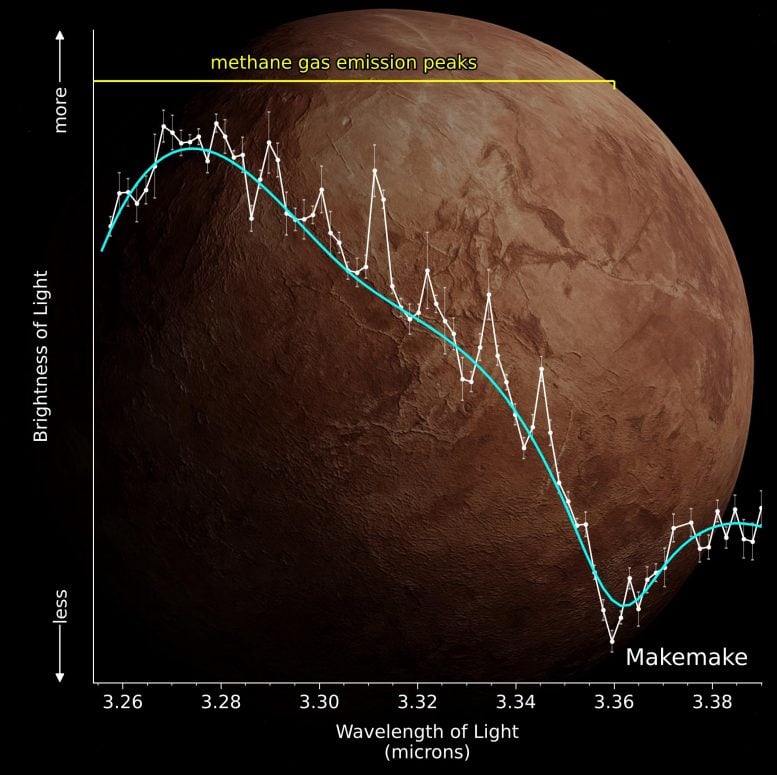
Methane gas may signal an atmosphere or geological activity on a distant dwarf planet located at the outer edge of the Solar System.
A research team led by the Southwest Research Institute has detected gas on the distant dwarf planet Makemake using NASA’s James Webb Space Telescope (JWST). With this finding, Makemake becomes only the second trans-Neptunian object, after Pluto, where gas has been confirmed. The gas was identified as methane.
“Makemake is one of the largest and brightest icy worlds beyond Neptune, and its surface is dominated by frozen methane,” said SwRI’s Dr. Silvia Protopapa, lead author of a new paper recently published in The Astrophysical Journal Letters. “The Webb telescope has now revealed that methane is also present in the gas phase above the surface, a finding that makes Makemake even more fascinating. It shows that Makemake is not an inactive remnant of the outer Solar System, but a dynamic body where methane ice is still evolving.”
Surface anomalies and thermal clues
The methane signal was identified as solar-excited fluorescence, meaning sunlight absorbed by methane molecules is re-emitted as spectral emission. Protopapa and her co-authors note that this could reflect the presence of a thin atmosphere in balance with surface ices — as seen on Pluto — or short-lived processes such as comet-like sublimation or cryovolcanic plumes. Both explanations remain possible and are consistent with the current data, though limitations in spectral resolution and background noise prevent a definitive conclusion.
Measuring about 890 miles (1,430 km) across, or roughly two-thirds the size of Pluto, Makemake has long captivated planetary scientists. Previous stellar occultations suggested the absence of a thick global atmosphere, though the existence of a faint one could not be excluded. In addition, infrared observations — including those from JWST — have revealed unusual thermal properties and anomalies in Makemake’s methane ice. These results have led to speculation about localized hot spots and possible outgassing from its surface.
Future Webb observations needed
“While the temptation to link Makemake’s various spectral and thermal anomalies is strong, establishing the mechanism driving the volatile activity remains a necessary step toward interpreting these observations within a unified framework,” said Dr. Ian Wong, staff scientist at the Space Telescope Science Institute and co-author of the paper. “Future Webb observations at higher spectral resolution will help determine whether the methane arises from a thin bound atmosphere or from plume-like outgassing.”
“This discovery raises the possibility that Makemake has a very tenuous atmosphere sustained by methane sublimation,” said Dr. Emmanuel Lellouch of the Paris Observatory, another co-author of the study. “Our best models point to a gas temperature around 40 Kelvin (-233 degrees Celsius) and a surface pressure of only about 10 picobars — that is, 100 billion times below Earth’s atmospheric pressure, and a million times more tenuous than Pluto’s. If this scenario is confirmed, Makemake would join the small handful of outer solar system bodies where surface–atmosphere exchanges are still active today.”
“Another possibility is that the methane is being released in plume-like outbursts,” added Protopapa. “In this scenario, our models suggest that methane could be released at a rate of a few hundred kilograms per second, comparable to the vigorous water plumes on Saturn’s moon Enceladus and far greater than the faint vapor seen at Ceres.”
The team’s research showcases the link between Webb observations and detailed spectral modeling, offering new insights into the behavior of volatile-rich surfaces across the trans-Neptunian region.
Reference: “Rotational Dynamics in Pulsational Pair-instability Supernovae: Implications for Mass Loss and Transient Events” by Trang N. Huynh, Emmanouil Chatzopoulos and Nageeb Zaman, 11 September 2025, The Astrophysical Journal.
DOI: 10.3847/1538-4357/adf4e7
The data used in this work were acquired with JWST’s Near-Infrared Spectrograph through Program 1254 (PI: A. H. Parker).
Never miss a breakthrough: Join the SciTechDaily newsletter.